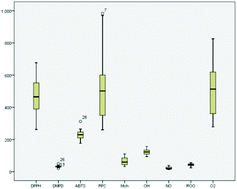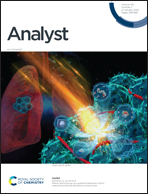Defining a standardized methodology for the determination of the antioxidant capacity: case study of Pistacia atlantica leaves†
Abstract
Antioxidant activity can be measured by a variety of methods, that include hydrogen atom transfer (HAT) and single electron transfer (ET) methods. Most of these techniques are spectrophotometric, and thus incapable of quantifying or indicting individual antioxidant compounds. Nowadays, the integration of chromatographic and chemometric approaches allows a high-throughput identification and activity prediction of herbal products. The ethyl acetate fraction from the aqueous-acetone extract of Pistacia atlantica leaves is frequently used for the isolation of antioxidants. In this study it is investigated for its antioxidant properties in order to define a potential methodology for the determination of the antioxidant capacity of herbal extracts (which need to be confirmed by future studies). The seven free radical assays evaluated can be divided into two groups depending on the oxidizing reagent. Three methods use stable, non-biological radicals, i.e. the diphenyl-1-picrylhydrazyl (DPPH) assay, the azinobis-(3-ethylbenzothiazoline-6-sulfonic acid) (ABTS) assay, and the N,N-dimethyl-p-phenylenediamine (DMPD) assay, which have no direct physiological importance. Four methods work with biological radical producers, including superoxide anion (O2˙−), hydroxyl (˙OH), nitric oxide (NO˙) and peroxyl (ROO˙) are produced metabolically in living organisms, and thus direct information on an extract's protective action is obtained. Furthermore, the reducing power method by potassium ferricyanide (RPC), and the iron (ferrous) ion chelating activity also have been investigated. The antioxidant activities of the samples were measured according to the different methods and modelled as a function of the HPLC fingerprints using the partial least squares (PLS) technique. The regression coefficients of the models were studied to indicate the peaks potentially responsible for the antioxidant activity. From the combined results of the different PLS models, we recommend using the DPPH, RPC and ROO˙ assays, to evaluate the overall antioxidant capacity; in the case study of P. atlantica leaves.



 Please wait while we load your content...
Please wait while we load your content...